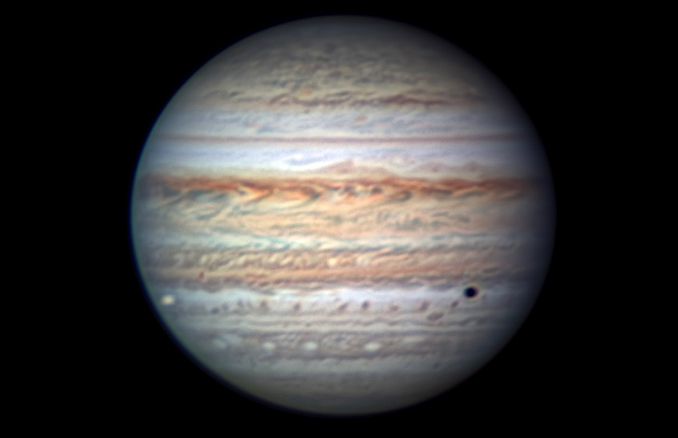
Keep the diary free towards the end of May to witness another very close conjunction between two of the major planets in the Solar System. In an echo of Jupiter’s early morning coming-together with dazzling Venus at the start of May, Jupiter and Mars are separated by just over half a degree before sunrise on 29 May. This time Jupiter is the brighter planet, outshining the red planet Mars by three magnitudes. Both planets lie low in a heavily twilight sky to the east-south-east in the run-up to dawn, so finding an observing spot with an unobstructed horizon is essential to get a good view.

Presently, Jupiter and Mars are located among the stars of south-eastern Pisces, with the red planet, shining at magnitude +0.75 and placed slightly higher in the sky, lying 5.4 degrees south-east (to the right of) of magnitude –2.24 Jupiter. At the beginning of the month, the planetary pair lay over 15 degrees apart.
At the beginning of civil twilight (when the Sun lies six degrees below the horizon) at 4.18am BST from London on the pre-dawn of Friday, May 20, both planets lie around 10 degrees high in the east-south-east. Unfortunately, their altitude progressively worsens towards more northerly parts of the UK; from Edinburgh, both planets lie around just four degrees high.

Before the main event, the Moon muscles in on the show to provide a picturesque if lowly scene for pre-dawn observers and imagers. On the morning of 25 May, a waning 25 per cent-illuminated crescent Moon lies about four degrees south of Jupiter and Mars. At this time they lie around 2.5 apart but by the pre-dawn of 28 May the planets are within a degree of each other, a separation persists for the next two mornings.
Closest approach, a separation of around 36 arcminutes (0.6 degrees), occurs on the following morning, the pre-dawn of Sunday, 29 May. Jupiter (magnitude –2.3) lies above and slightly to the left of Mars (+0.7) in the east-south-east. By about 4am from London (the beginning of civil twilight) Jupiter has climbed to an altitude of around 12.5 degrees from London (nearly 19 degrees by sunrise).

The scenario is barely worse on the following pre-dawn, Monday, 30 May, when Jupiter and Mars have just over 42 arcminutes of Pisces real estate between them. By the end of May, the pair are separated by 1.3 degrees.
In case the sky is hazy, it’ll be a good idea to have a pair of binoculars or a portable small telescope on hand. Jupiter’s disc, around 37 arcseconds in apparent diameter, could be discerned if the seeing is not too destructive, though Mars’ comparatively tiny 6.3 arcsecond globe will probably be too challenging to resolve telescopically.
During June, Jupiter and Mars gradually move further apart, both on their way to a much-improved morning outlook by mid-summer. In mid-June they lie nearly ten degrees apart.




